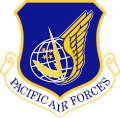459th Airlift Squadron  | |
|---|---|
 The first squadron C-12J arriving at Yokota Air Base, 29 June 2007 | |
| Active | 1942–1944; 1944–1945; 1952–1952; 1966–1970; 1975–1993; 1993–present |
| Country | |
| Branch | |
| Role | Airlift |
| Part of | Pacific Air Forces |
| Garrison/HQ | Yokota Air Base |
| Decorations | Distinguished Unit Citation Presidential Unit Citation Air Force Outstanding Unit Award Republic of Vietnam Gallantry Cross with Palm |
| Insignia | |
| 459th Airlift Squadron emblem [a] [1] |  |
| 459th Airlift Squadron emblem [b] [2] |  |
| 459th Bombardment Squadron emblem [c] [1] |  |
The 459th Airlift Squadron is an active United States Air Force unit assigned to the 374th Airlift Wing at Yokota Air Base, Japan. It has been stationed at Yokota since 1993. It has performed its current mission since activating in 1975 as the 1400th Military Airlift Squadron. The 1400th Squadron was consolidated with the 459th in 1991.
Contents
- Mission
- History
- World War II
- Air Force reserve
- Vietnam War
- Administrative airlift
- Lineage
- Assignments
- Stations
- Aircraft
- Awards and campaigns
- References
- Notes
- Bibliography
- External links
The squadron was first activated during World War II as the 459th Bombardment Squadron. It was a replacement training unit for heavy bomber crews until being inactivated in the spring of 1944 when the Army Air Forces reorganized its training and support units in the United States. It was reactivated the same day as a Boeing B-29 Superfortress unit. The unit deployed to the Pacific Ocean Theater in early 1945 and participated in the strategic bombing campaign against Japan until V-J Day, earning two Distinguished Unit Citations for its actions. The squadron returned to the United States in December 1945 and was inactivated.
The squadron was redesignated the 459th Troop Carrier Squadron and activated in the reserve in 1952, but was quickly inactivated as reserve units that had been mobilized for the Korean War were released from active duty. As the Air Force assumed the light airlift mission from the Army, the squadron was again activated on New Year's Day 1967. It served in combat in Vietnam until June 1970, earning an additional Presidential Unit Citation and three Air Force Outstanding Unit Awards with Combat "V" Device before inactivating in theater.





